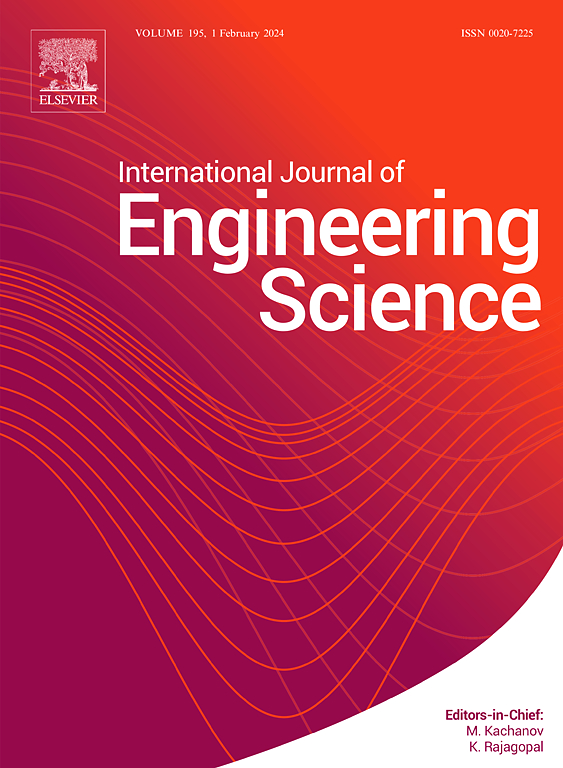Indeterminacy and well-posedness of the non-local theory of Rayleigh waves
IF 5.7
1区 工程技术
Q1 ENGINEERING, MULTIDISCIPLINARY
International Journal of Engineering Science
Pub Date : 2025-06-25
DOI:10.1016/j.ijengsci.2025.104321
引用次数: 0
Abstract
The latest literature stance holds that, in a 2D framework, the non-local theory of elasticity, as developed by Eringen, is fundamentally inconsistent because “it does not satisfy the equations of motion for [the] non-local stresses”. In fact, it is believed that the differential form of this theory, that is accessible when the attenuation function is a Green function and that is well-posed, gives different results from the integral formulation. We show that these ideas are ill-conceived, provided that we adopt the kernel modification approach, by which the constitutive boundary conditions (CBCs) embedded in the integral formulation are reconciled with the natural boundary conditions of the problem at hand. Indeed, this kernel modification strategy, which was first introduced by the authors for 1D non-local models, is necessary to avoid that the problem becomes over-constrained through (possibly conflicting) natural and constitutive boundary conditions, and consequently ill-posed. Once the problem is made well-posed, we show that (1) failure to satisfy the equations of motion is not only expected, but it is in fact necessary, (2) for the example case of surface waves propagating in a stress-free half-plane, the integral and the differential formulations coincide, (3) for a force problem, the non-local theory is generally indeterminate because it lacks compatibility: consequently, for a unique solution, an extra boundary condition is needed, and (4) multiple Rayleigh wave branches appear as a consequence of non-locality.
非定域瑞利波理论的不确定性和适定性
最新的文献立场认为,在二维框架中,由Eringen提出的非局部弹性理论从根本上是不一致的,因为“它不满足非局部应力的运动方程”。事实上,我们相信,当衰减函数是格林函数时,这个理论的微分形式是可行的,并且是适定的,它给出了与积分公式不同的结果。我们表明,这些想法是错误的,只要我们采用核修正方法,通过该方法,嵌入积分公式中的本构边界条件(CBCs)与手头问题的自然边界条件相协调。事实上,这种核修正策略是必要的,它首先由作者为一维非局部模型引入,以避免问题因(可能冲突的)自然和本构边界条件而变得过度约束,从而导致不适定。一旦问题得到良好的定姿,我们表明:(1)不满足运动方程不仅是预期的,而且实际上是必要的;(2)对于表面波在无应力半平面上传播的例子,积分和微分公式是一致的;(3)对于力问题,非局部理论通常是不确定的,因为它缺乏兼容性;因此,对于唯一解,需要一个额外的边界条件,并且(4)由于非局域性而出现多个瑞利波分支。
本文章由计算机程序翻译,如有差异,请以英文原文为准。
求助全文
约1分钟内获得全文
求助全文
来源期刊

International Journal of Engineering Science
工程技术-工程:综合
CiteScore
11.80
自引率
16.70%
发文量
86
审稿时长
45 days
期刊介绍:
The International Journal of Engineering Science is not limited to a specific aspect of science and engineering but is instead devoted to a wide range of subfields in the engineering sciences. While it encourages a broad spectrum of contribution in the engineering sciences, its core interest lies in issues concerning material modeling and response. Articles of interdisciplinary nature are particularly welcome.
The primary goal of the new editors is to maintain high quality of publications. There will be a commitment to expediting the time taken for the publication of the papers. The articles that are sent for reviews will have names of the authors deleted with a view towards enhancing the objectivity and fairness of the review process.
Articles that are devoted to the purely mathematical aspects without a discussion of the physical implications of the results or the consideration of specific examples are discouraged. Articles concerning material science should not be limited merely to a description and recording of observations but should contain theoretical or quantitative discussion of the results.
 求助内容:
求助内容: 应助结果提醒方式:
应助结果提醒方式:


